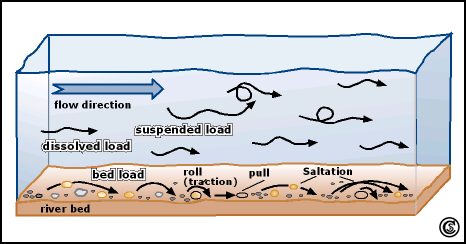Fluvial transport
This can be separated into three components, each of them transported by another mechanism (see figure):
- dissolved load: ions, molecules and atoms emanating from the solution of solid substances. These are carried in solution.
- suspended load: solid particles which are small and light enough to be held in suspension. These are carried in suspension.
- bedload: Solid particles which are transported on the river bed. These are transported by traction and saltation (Knighton 1998).
During the transport the particles are gradually reduced in size and rounded (attrition).
As erosion on hill slopes is the main source of the transported material the transport rate can be considered to be a geomorphological measure for the total rate of soil loss of the watershed above the measuring point. Thus, the transport rate is a measure for the fluvial morphodynamic within a watershed. For calculation of the transport rate [m3/year] several steps have to be done:
- measure the mass of load at a specific location of the river course;
- divide the mass by the specific density of the rock material. This results in the transported volume;
- divide the transported volume by the period of measurement. The result is the transport rate.
The average loss of soil in the watershed above this measuring point you can estimate by division of the transport rate through the area of the watershed.
The ability of the river to transport is related exponentially to the flow velocity and discharge:
- increasing discharge result in increased flow velocity disproportionately (up to eight times);
- the friction force of flowing water increases in quadrate of the flow velocity.
As long as the friction force is adequate the river transports its load in direction to the ocean. If this is decreasing the river deposits its load.
